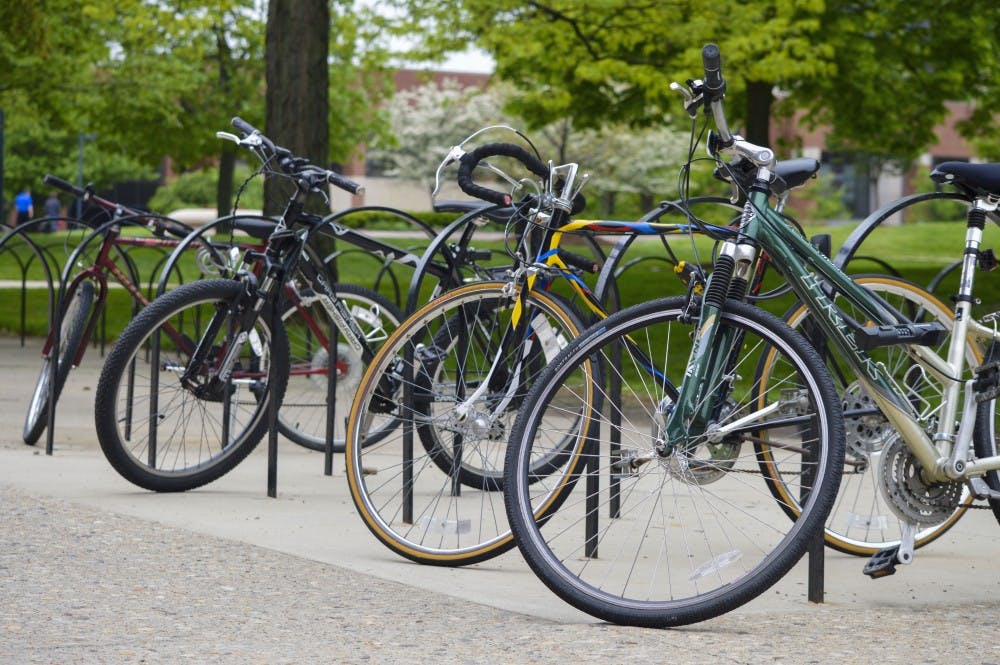When McKinley Avenue was redesigned in the 2000s, the newly implemented medians helped create a safer main street for cars and pedestrians alike. But one group was left out: bicyclists.
Now the university is focusing on those who ride to campus by creating a bicycle masterplan with the firm Rundell Ernstberger Associates (REA). This could mean painted bike lanes or even the creation of separate bicycle paths throughout campus. However, the end results are years away.
As part of the beginning steps of the bicycle masterplan, REA hosted a bicycle masterplan open forum Wednesday night to gage opinions on how bike-friendly Ball State's campus is and potential solutions. Students and faculty drew on large maps, indicating problem areas between pedestrians and cars, where they like to ride currently and where they would like to see more bicycle paths in the future.
For most Ball State faculty members and students in attendance, Ball State's current status isn't friendly enough to those who use two wheels.
“Muncie has quite a bit of bike-able places, but for Ball State there is a lot of conflict,” said Jacob Dines, a senior landscape architecture major. “It gets crowded any time it's between classes. You just can't ride a bike; you've got to walk it. Otherwise, it's just not safe.”
Last school year, at least two bicyclist were hit by cars on campus, one of which ended up going to the ER due to a concussion.
Daniel Liggett, an associate at the firm, said they won't release recommendations to the university until their first draft is released in February or March. However, there were some common themes in how students and faculty marked up the maps Wednesday night.
“We heard a lot of people biking on the street, and they were either uncomfortable or there wasn't a lot of space for them to do that. And also people were biking on the sidewalk and there was a lot of conflicts with pedestrians, especially on campus along McKinley,” Liggett said. “I think a common theme we heard ... was that a dedicated space for bikes was important.”
Some potential solutions Liggett mentioned were painting bike lanes on the already existing McKinley Avenue, however that wouldn't leave much space for bikers and cars to share the road. Another likely option, rather than widening McKinley Avenue, would be to add a bicycle path in the area West of Noyer and Woodworth Complex, with the idea that bicyclist would travel there instead of down the main drag.
The university already planned to update that space, known as the East Mall, with a bike path in the Campus Master Plan.
Applied Technology professor Thomas Spotts usually just tries to avoid McKinley Avenue. But the only other option right now is the path behind the Art and Journalism and Robert Bell buildings. He doesn't love using it, since it is a pedestrian walkway.
“A bicycle is a vehicle; it belongs on the road,” Spotts said. “I don't like [using the path,] but I'd rather weave in and out of people than I would cars. They're a little bigger, and they tend to have an advantage.”
Another point of conflict is along Bethel Avenue as students and faculty living north of campus, like Spotts, try to cross the street. The easiest solution in that case could be a bike path on the Ball State side of Bethel Avenue, Liggett said. Right now it's lined with trees, so bicyclist have to cross at the Bethel and N. Oakwood intersection – where only a stop sign impedes the flow of traffic.
However, all of those solutions are simply just possibilities currently and may or may not end up in the firm's recommendations. In regards to timing and price, it all depends on how complex of changes Ball State makes. There is a big difference in cost between road paint and creating stand-alone bike paths.
“Really, we're just at the beginning stages of this, so we haven't made any recommendations or really too many discussions about proposed facilities or proposed bike routes,” Liggett said during the open house. “We want the information we hear during this meeting to dictate that.”





